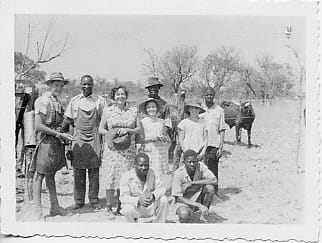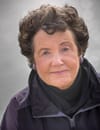We had a Farm in Africa

Our Family at the Farm. Far L Brian, our “cookboy” John, Mom, Felon head “herd boy”, “herdboy”, middle me and David, crouching another “herdboy” and Sugah our “gardenboy”.
We Had a Farm in Africa
The farm was acquired as a foreclosure when the second Hunt brother (of Hunter’s Road) succumbed to a coronary and the widows needed to sell. There were no buyers. The bank urged Dad to take over the residual mortgage indebtedness.
We Had a Farm in Africa
The bailout made us farmers: Dad’s only capital investment. It was 1956. No sooner had the deal been done than Dad was surprised with a curt letter informing him of one month’s notice on his mine appointment. The hospital would be closing. The new mine manager decided the Government could cope with any sick African miners and their families. Dad was happy to see the last of Sick Parade and the mine practice. He had established his own private practice in town. But this meant we would lose the large rambling house with the big shady garden at #1 Silver Oaks Road that we all loved so much. He insisted on the three months notice to vacate the house as stipulated in his employment agreement. The manager accepted with poor grace.
Dad’s only capital was invested in the newly acquired farm. He called in the Conservation Department to assess the soil, irrigation, crops and livestock potential. They declared it an uneconomic farming unit and permitted subdivision into 11 plots.
People were looking for a place to call their own on which to potter. One by one the plots sold for a song. As they did we built our new house on five acres just outside of town, renting a house nearby in the interim.
Meanwhile one of the plot holders, an old diehard smallworker who had thought his luck was in when he bought the plot, asked Dad to buy it back. He was strapped for cash. It was not an unusual story. Of the 269 distinguishable deposits around Que Que the six largest mines around Que Que accounted for 88% of the gold.
We all rushed out to explore the farm. Agriculturally the 288 acres was the worst plot, but from the scenic point of view it was, reportedly, the best.
It was hard to see exactly what we had acquired, though. The tall elephant grass dotted about with thorn trees obscured a long distance view. There was a trickle of a stream called Lion Spruit or Zabola Spruit, depending on which map one was looking at, that ambled its way between fine specimens of combretum to empty itself into the Que Que River at the opposite end of the plot. A lot of the fine timber had been cut down years ago.
Structurally there was not much to see. There were three forty four gallon drums, rusty with no tops or bottoms and the beginnings of a house consisting of ant eaten tree trunks stuck into six inches of foundation and all bound together by odd bits of wire.
Dad was appalled. We all had our opinions. Mom thought perhaps we could dam the spruit and fish farm. A pump would make Girl Guide camps possible all year round, with a little cottage somewhere for family affairs where Dad could get away from everything and be un-findable.
Brian thought it might be good for camping. I thought I might have a horse there some day (though I wasn’t comfortable in the back of a horse, and knew it). The birds were wonderful. David wondered about the wildlife and suggested we put some elephant on it.
Instead we put some cattle on it and called it Rise ‘n Shine.
Thanks to Bob Atkinson of Pretoria for copy of The Economic Geology of the Country around Kwe Kwe. Bulletin No 67 Part II and many other materials.
